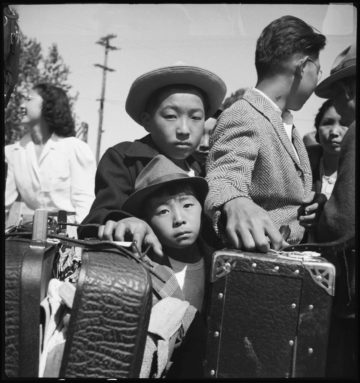
Originally published in the Marina Times San Francisco in January 2019
“ First They Came” is a poem written by the German Lutheran pastor and theologian Martin Niemöller about cowardice in the face of the rise of the Nazi party leading up to World War II. The United States Holocaust Memorial Museum quotes this portion of the text:
First they came for the socialists, and I did not speak out—
Because I was not a socialist.
Then they came for the trade unionists, and I did not speak out—
Because I was not a trade unionist.
Then they came for the Jews, and I did not speak out—
Because I was not a Jew.
Then they came for me—and there was no one left to speak for me.
From January 18th through May 27, 2019, the Jonathan Logan Family foundation partners with the National Japanese American Historical Society and J-Sei to present Then They Came for Me, a multimedia exhibit featuring notable photographers including Dorothea Lange, Clem Albers and Ansel Adams along with the U.S. government’s War Relocation Authority’s commissioned photographers.
This story began with Executive Order 9066, issued on February 19, 1952. Franklin D. Roosevelt’s order authorized the Secretary of War to assign areas as military zones “…from which any or all persons may be excluded.” Exclusion came to mean Japanese Americans who were then moved to internment camps out of racially motivated fear instead of a justifiable military necessity.
The exhibition tells the stories of the forced removal of 120,000 Japanese American citizens from their homes without due process or constitutional protections. Photos documenting Japanese American citizens being evicted from their homes and their subsequent lives in the camps are taken from the images discovered in the National Archives for the book Un-American: The Incarceration of Japanese Americans During World War II by Chicago-based photographers Richard Cahan and Michael Williams. Included are artifacts made by incarcerees, historical documents, and images of daily life in the camps by artists and inmates Toyo Miyatake and Mine Okubo. One of the dominant themes of this exhibit is the state-sanctioned racism that encouraged anti-Japanese sentiments at the end of the 19th century. The condition of the camps and the irreparable harm done to Japanese American citizens included loss of personal properties, businesses and a stripping of identity since the dark message was received and understood that they were outcasts.
Then They Came For Me will host a series of programs featuring author Duncan Williams with musician scholars No No Boy. Kambara + Dancers and a talk about tracing the subjects of Dorothea Lange’s photographs with photo historians Richard Cahan and Michael Williams along with Lange’s official biographer, Elizabeth Partridge. Additional events will include conversations on the current state of U.S. immigrant detention camps, the Muslim Ban and rise of Islamophobic hate crimes, film screenings, music, family activities and more. Then They Came for Me is located at 100 Montgomery Street, The Presidio, San Francisco with a public reception on January 18, 2019 from 7 to 9 pm.
Extended through Spring 2019 at the Presidio Officer’s club is a current special exhibition, Exclusion: The Presidio’s Role in World War II Japanese American Incarceration. The Presidio, as headquarters of the Western Defense Command, was a source of 108 civilian exclusion orders. These actions forced evacuation of Japanese Americans for the duration of the war. “The Presidio of San Francisco played a pivotal role in the mass incarceration of Japanese Americans during World War II”, explains Presidio Trust Curator Liz Melicker. “This exhibition encourages reflection and invites visitors to investigate the issues and decisions that led to this dark chapter in American history. How did leaders arrive at the decision to incarcerate Japanese Americans, two-thirds of whom were U.S. citizens? How did Japanese Americans and others respond to the violation of their civil liberties? And what, as a nation, have we learned that can help us address present-day issues such as mass incarceration, immigration reform, and racial profiling?” The Presidio hopes the exhibit will start a meaningful dialogue to use the lessons of the past to transform injustice into tolerance and acceptance.